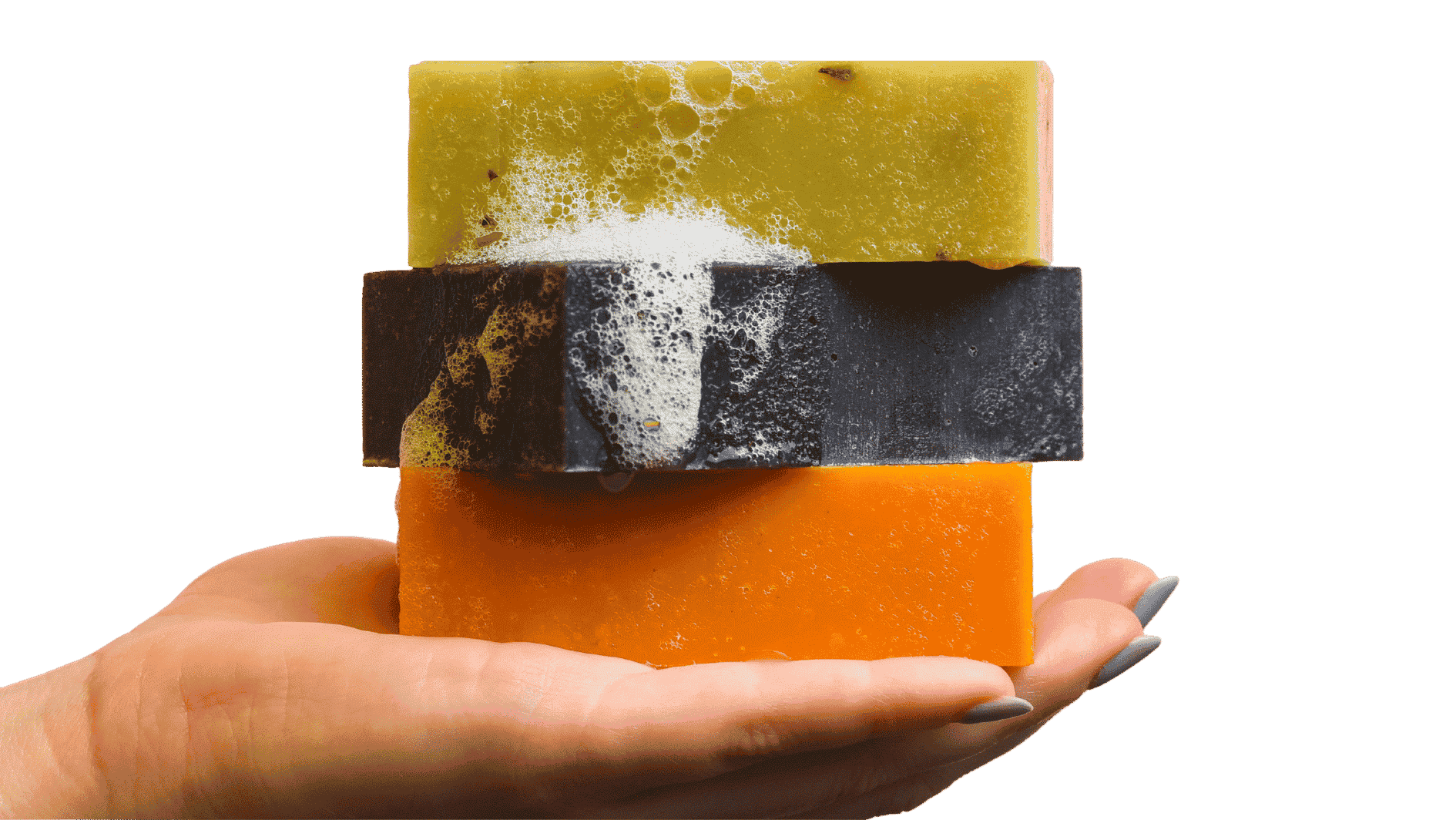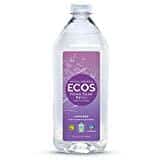

Photo by Aurélia Dubois on Unsplash
For those who struggle with sensitive or dry skin, natural soap may be an eco-friendly remedy. Commercially made soaps sometimes lack moisturizing ingredients and contain preservatives that help soap to foam up but also leave your skin feeling stripped, raw and itchy.
Even the FDA has stated that mass-produced soaps, whether in liquid or bar form, aren’t really soap, but rather synthetic detergent products. This makes it even more compelling to seek out natural soaps made from moisturizing, organic and skin-enriching ingredients.
Natural and organic soaps are made from nature-derived ingredients that help your skin to stay soft, and moisturized without any added toxic chemicals. They’re also better for the environment, as nothing unnatural will enter the water stream when that soap goes down the drain. Let’s take a look at the seven best natural soaps on the market today.
7 Best Natural Soaps
Based on our market research, these are the best natural soap bars and liquid soaps available.
Each product featured here has been independently selected by the writer. If you make a purchase using the links included, we may earn commission.
- Best Overall: EcoRoots Facial Soap and Body Wash Bars
- Best Multi-Purpose Soap: Dr. Bronner’s Pure Castile Liquid Soap
- Best for Sensitive Skin: Tom’s of Maine Natural Beauty Bar Soap for Sensitive Skin
- Best Allergen-Free Soap: Grandma’s Pure Lye Soap Bar
- Best Hand Soap: ECOS Hypoallergenic Hand Soap
- Best Face Wash: Ursa Major Fantastic Face Wash
- Best Body Wash: Avalon Organics Bath and Shower Gel
- Best for the Environment: Ethique Eco-Friendly Bodywash Bar
What is Natural Soap?
Most natural soap is made from a combination of oil, lye (which contains water and either sodium hydroxide or potassium hydroxide) and sometimes essential oils and natural colorings.
Many soaps you find on store shelves are filled with chemical fragrances and dyes, harmful sulfates and unsustainable ingredients like non-certified palm oil. Natural soap doesn’t contain any synthetic chemicals or harsh active agents (also called surfactants). Because your skin is a highly absorbent organ, switching to a natural soap isn’t just better for your epidermis, but for your whole body.
Our Recommendations for Natural Soap
If you’re ready to lather up naturally, read on to learn more about some of the best natural soaps on the market today.
Best Overall: EcoRoots Facial Soap and Body Wash Bars

EcoRoots’ Facial Soap and Organic Body Soap are cold-pressed by hand in small batches and work for all skin types — including sensitive skin. With fresh scents like orange bergamot, lavender and spearmint sage, you’re sure to find a bar you love. Plus, they’re more eco-friendly than their plastic-packaged counterparts. Each bar can prevent up to three plastic soap bottles from entering the waste stream, and the company ensures plastic-free shipping and recyclable packaging.
Customer Rating: 5 out of 5 stars with over 115 EcoRoots ratings
Why Buy: These organic soaps use ingredients like bamboo charcoal and oatmeal to cleanse skin and provide nourishment. They’re vegan and cruelty free and contain no parabens, sulfates, synthetic fragrances or colorants. EcoRoots supports 1% For the Planet and donates a portion of sales to organizations such as Ocean Conservancy.
Best Multi-Purpose Soap: Dr. Bronner’s Pure-Castile Liquid Soap

Dr. Bronner’s has been in the soap game for over a century, and its Pure-Castile Soap consistently tops best-seller lists for a reason. This natural soap is not only good for washing your face, hair and body, but it also can be diluted and used as an eco-friendly cleaning product for laundry, dishes, mopping and more. It’s good for you and the planet, because when it’s diluted, you get more bang for your buck and use less soap, meaning less packaging waste in the long run.
Customer Rating: 4.8 out of 5 stars with over 19,200 Amazon ratings
Why Buy: This pure castile soap utilizes a vegan, cruelty-free formula that’s great for sensitive skin. It’s made from organic oils and certified fair trade ingredients that are sustainably sourced from places with ethical working conditions and fair wages. The liquid soap is biodegradable and isn’t made with synthetic preservatives, detergents or foaming agents.
Best for Sensitive Skin: Tom’s of Maine Natural Beauty Bar Soap for Sensitive Skin

Tom’s of Maine Natural Beauty Bar Soap is gentle on skin and helps you retain your body’s natural moisture. It’s hypoallergenic, vegan and made with Rainforest Alliance Certified palm oil. If you need another reason to purchase this natural soal, 10% of Tom’s of Maine’s profits go to nonprofits working on issues including education, children’s health and the environment.
Customer Rating: 4.6 out of 5 stars with over 150 Amazon ratings
Why Buy: This bar soap’s formula is tested by dermatologists and is fragrance-free. It’s made with natural ingredients like aloe vera and coconut oil, making it a good choice for those with sensitive skin. Tom’s of Maine doesn’t test on animals and doesn’t sell products with artificial fragrances, parabens or preservatives.
Best Allergen-Free Soap: Grandma’s Pure Lye Soap Bar

This all-natural soap may be a great face and body cleanser for those who suffer from acne, eczema, psoriasis, rosacea or another skin condition. This is because it’s made with just three ingredients: food-grade lard, water and lye. Grandma’s unscented soap bar could also be good for soothing bug bites, rashes and poison ivy. (But do note that it’s not vegan if that’s something you’re looking for in your natural soap.)
Customer Rating: 4.6 out of 5 stars with over 900 Amazon ratings
Why Buy: This pure lye soap is Mayo Clinic SkinSafe certified, which means it’s guaranteed to be free of harmful chemicals that cause allergies and cause itchy skin. The formula is detergent-free and doesn’t have any additives that trigger dryness or irritation.
Best Hand Soap: ECOS Hypoallergenic Hand Soap

Lemongrass-scented ECOS Hypoallergenic Hand Soap is non-drying and helps to soften skin with ingredients like vitamin E. Its gentle formula can also help to maintain the thin film on the skin’s surface called the acid mantle. This biodegradable, pH-neutral soap is an Environmental Protection Agency Safer Choice-certified product and is made with plant-based ingredients.
Customer Rating: 4.6 out of 5 stars with over 800 Amazon ratings
Why Buy: This hand soap is infused with vitamins, antioxidants and organic essential oils helping moisturize and protect hands. Its formula doesn’t include any formaldehyde, petrochemicals, GMOs, phosphates, chlorine or ammonia. ECOS is a cruelty-free brand and never tests on animals.
Best Face Wash: Ursa Major Fantastic Face Wash

Natural, organic and vegan skin care products can be hard to come by. Ursa Major’s face wash helps brighten, exfoliate and hydrate skin. This natural face wash is a foaming gel cleanser that has a woodsy aroma, as it’s infused with cedar, spearmint, lime, lemon, rosemary, black spruce, vetiver and lavender. It’s good for those with normal, oily or combination skin.
Customer Rating: 4.6 out of 5 stars with over 1,000 Amazon ratings
Why Buy: This face wash is made with natural ingredients including lemon to exfoliate, aloe to hydrate and sugar maple to help brighten the skin. The formula also uses rice seed and coconut-derived surfactants. It is sulfate-free, paraben-free and cruelty-free and doesn’t contain any petrochemicals, sulfates, synthetic fragrances, colors, silicones or glycols.
Best Body Wash: Avalon Organics Bath and Shower Gel

Avalon Organics Bath and Shower body soap has a calming aroma of lavender essential oils that helps to soothe the body. It gently cleanses and hydrates the skin by using natural and organic ingredients that meet NSF/ANSI 305 Personal Care standards. This formula of this body gel also meets the Environmental Working Group’s strict criteria for ingredients, transparency and health.
Customer Rating: 4.4 out of 5 stars with over 5,800 Amazon ratings
Why Buy: Along with meeting NSF/ANSI 305 and EWG standards, Avalon Organics’ natural soap is certified USDA Organic and Leaping Bunny cruelty-free. It’s a vegan formula that doesn’t have any parabens, phthalates, synthetic colors or fragrances.
Best for the Environment: Ethique Eco-Friendly Bodywash Bar

Ethique works to eliminate plastic waste by using compostable, plastic-free packaging. The company’s Eco-Friendly Bodywash Bar is made with essential oils and olive oil, which creates a creamy, moisturizing natural soap. Ethique’s selection of body wash bars includes scents like orange-vanilla, peppermint-lavender, lime-ginger and more. They are suitable for any skin type.
Customer Rating: 4.3 out of 5 stars with over 1,400 Amazon ratings
Why Buy: This product is 100% vegan, cruelty-free and palm-free. Each year, 20% of Ethique profits go to charities that are improving the environment. The ingredients are ethically sourced, sustainable and natural.
Frequently Asked Questions About Natural Soap
What is the most natural soap?
The most natural soaps are ones made with few ingredients. Most of the best natural soap brands use plant-based ingredients, but some use animal-derived ingredients like lard, which has been used in traditional soap making for thousands of years.
Is natural soap better for your skin?
Your skin is an absorbent organ, and the toxic chemicals that you apply to it have a fair chance of ending up in your bloodstream. Natural soap not only prevents this, but it’s also more gentle on your skin, making it less prone to irritation.
What is the best soap without chemicals?
According to our research, EcoRoots’ face and body bars are the best natural soaps. We also highly recommend Dr. Bronner’s Pure-Castile Liquid Soap and Tom’s of Maine Natural Beauty Bar Soap for Sensitive Skin.
Is natural soap better for the environment?
Natural soap is much better for the environment than soap made with synthetic materials. Most soaps wash off with water, and when that water goes down the drain, it carries the soap’s ingredients along with it. If you use soaps formulated with toxins and synthetic chemicals, those ingredients will make their way through the wastewater stream and end up in lakes, rivers, oceans and other bodies of water.
- Natural Remedies for Eczema: What You Should Know - EcoWatch
- 2021 Best CBD Skincare Products: Reviews and Guide - EcoWatch
- The 5 Best Natural Shampoo Brands (Vetted By Experts) - EcoWatch
- 6 Best Eco-Friendly Cleaning Products of 2021
- 6 Best Natural Mosquito Repellents That Actually Work (2021) - EcoWatch
- 4 Best Portable Washing Machines of 2022

 233k
233k  41k
41k  Subscribe
Subscribe 